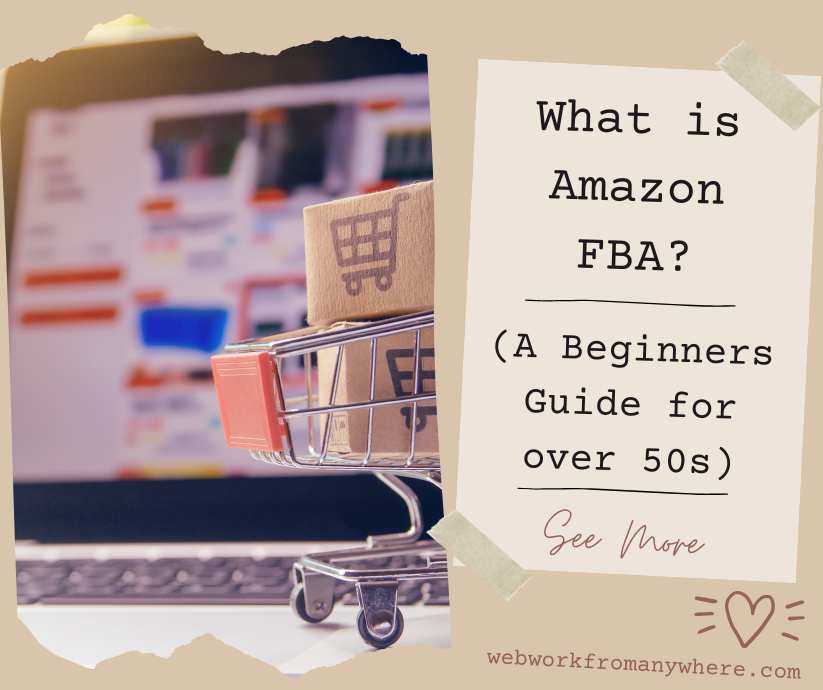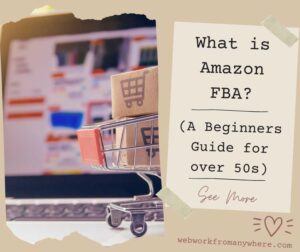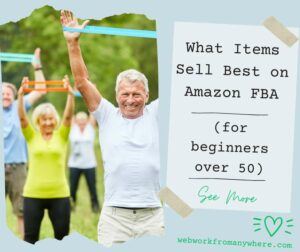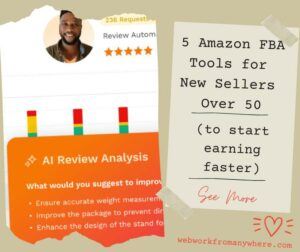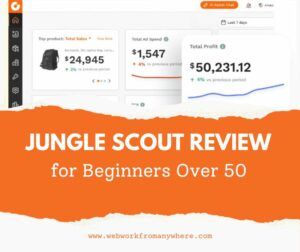Welcome to Part One of my Amazon FBA series designed specifically for entrepreneurs over 50! This series covers things you need to know about selling on Amazon. Including reviews of essential tools like Jungle Scout, Helium 10, AMZScout, and SellerAMP, plus proven product ideas that work.
This beginner-friendly business model lets you sell products online without handling shipping, customer service, or storage headaches – Amazon does the heavy lifting while you focus on growing your business.
- 1. What Does Amazon FBA Actually Mean?
- 2. How Does Amazon FBA Work Step-by-Step?
- VIDEO: How to Send Your First Shipment to Amazon
- 3. Why Is Amazon FBA Perfect for Beginners Over 50?
- 4. What Are the Real Benefits?
- 5. What Are the Honest Drawbacks?
- 6. How Much Money Do You Need to Start?
- 7. What Kind of Products Should You Sell?
- 8. How Long Does It Take to See Profits?
- VIDEO: How to Make Your First $1,000 With Amazon FBA! JungleScout Advice
- 9. Do You Need Special Skills or Experience?
- 10. What Are the Biggest Mistakes Beginners Make?
- 11. Is Amazon FBA Right for You?
- 12. How Do You Get Started?
See the Whole Amazon FBA Series here…
1. What Does Amazon FBA Actually Mean?
FBA stands for “Fulfillment by Amazon.” Think of it as having Amazon act as your personal warehouse manager, shipping clerk, and customer service representative all rolled into one.
Here’s how it works: You find products to sell, send them to Amazon’s warehouses, and when someone buys your item, Amazon picks, packs, ships it, and even handles returns. You get paid, minus Amazon’s fees, without ever touching the product after you send it to them.
For example, imagine you’re selling kitchen gadgets. Instead of storing boxes in your garage and rushing to the post office every time someone places an order, Amazon handles all of that for you from their massive distribution centers.
The 6 million question you need to solve is ‘what to sell?’, that’s where the tools I recommend help you in that search. I also share YouTube videos that show you how to find profitable products. Since that’s what it’s all about! Creating a sustainable online business.
2. How Does Amazon FBA Work Step-by-Step?
Step 1: Set up Your Amazon Seller Account. You need a Professional Seller Account on Amazon Seller Central.
Step 2: Find Your Product You research and source products to sell. This could be anything from phone accessories to garden tools to specialty foods.
Step 3: Send Products to Amazon You ship your inventory to Amazon’s fulfillment centers. They store your products alongside millions of others. For this you’ll also need bar codes and ID Labels on your shipments.
Step 4: List Your Products You create product listings on Amazon with photos, descriptions, and pricing.
Step 5: Amazon Takes Over When customers order your products, Amazon handles storage, packing, shipping, customer service, and returns.
Step 6: You Get Paid Amazon deposits your profits (minus their fees) directly into your bank account every two weeks.
VIDEO: How to Send Your First Shipment to Amazon
3. Why Is Amazon FBA Perfect for Beginners Over 50?
You Don’t Need to Be Tech-Savvy While you’ll need some computer skills, you don’t need to build websites or understand complex e-commerce platforms. Amazon’s seller interface is straightforward, and there are plenty of tutorials available.
No Heavy Lifting Required Once you send your products to Amazon, there’s no physical handling involved. No more worrying about packaging fragile items or making trips to the shipping store.
Leverage Amazon’s Reputation Customers trust Amazon. When you sell through FBA, your products get the coveted “Prime” badge, which means faster shipping for Amazon Prime members – and they’re more likely to buy from you.
Flexible Schedule You can work when you want, where you want. Many successful FBA sellers spend just a few hours a week managing their business once it’s established.
4. What Are the Real Benefits?
Professional Customer Service Amazon’s customer service team handles all inquiries, complaints, and returns. No more dealing with upset customers at 9 PM on a Sunday.
Global Reach Your products can be discovered by millions of Amazon shoppers worldwide without any marketing expertise on your part.
Predictable Costs Amazon’s fee structure is transparent, so you can easily calculate your profits before investing in inventory.
Passive Income Potential Once your products are selling well, the business can generate income while you sleep, travel, or focus on other activities.
See the Series on Amazon FAB for beginners.
- Jungle Scout Review for Beginners Over 50
- 5 Amazon FBA Tools for New Sellers Over 50 (to start earning)
- What Items Sell Best on Amazon FBA for Beginners?
5. What Are the Honest Drawbacks?
Upfront Investment Required You’ll need money to buy inventory before you see any returns. Starting amounts can range from $1,000 to $10,000 or more, depending on your chosen products.
Amazon Controls Your Business Amazon can change rules, suspend accounts, or remove products without warning. You’re building on someone else’s platform.
Fees Add Up Amazon charges multiple fees: storage fees, fulfillment fees, referral fees, and more. These typically range from 25-35% of your selling price.
Competition Is Fierce Popular products often have dozens or hundreds of sellers. You’ll need to find ways to stand out or discover less competitive niches.
Inventory Management Challenges Running out of stock means lost sales. Ordering too much ties up your cash and incurs storage fees.
6. How Much Money Do You Need to Start?
Most experts recommend starting with at least $2,500-$5,000. Here’s a realistic breakdown:
- Product Inventory: $1,500-$3,000
- Amazon Seller Account: $39.99/month (professional account)
- Product Research Tools: $50-$100/month (optional but helpful)
- Initial Shipping to Amazon: $100-$300
- Buffer for Unexpected Costs: $500-$1,000
Remember, this is a business investment. You wouldn’t expect to start any brick-and-mortar business with less.
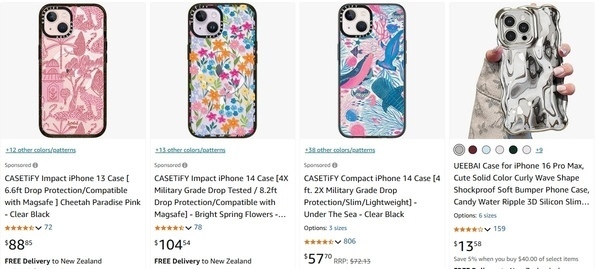
7. What Kind of Products Should You Sell?
Good Products for Beginners:
- Items between $15-$50 (good profit margins without huge upfront costs)
- Lightweight products (lower shipping and storage fees)
- Non-fragile items (fewer damage issues)
- Products with consistent demand (not seasonal fads)
Examples of Beginner-Friendly Products:
- Kitchen utensils or gadgets
- Pet accessories
- Phone or tablet accessories
- Organizational tools
- Beauty or personal care items
Products to Avoid:
- Anything requiring FDA approval
- Fragile or oversized items
- Highly competitive branded products
- Seasonal items (unless you really know what you’re doing)
8. How Long Does It Take to See Profits?
Realistic Timeline:
- Month 1-2: Product research, sourcing, and setup
- Month 3-4: First inventory arrives and goes live
- Month 5-6: Start seeing consistent sales and feedback
- Month 6-12: Optimize listings, expand successful products
Most successful sellers don’t see significant profits until months 6-12. This isn’t a get-rich-quick scheme—it’s a legitimate business that requires patience and persistence.
VIDEO: How to Make Your First $1,000 With Amazon FBA! JungleScout Advice
9. Do You Need Special Skills or Experience?
What Helps:
- Basic computer and internet skills
- Willingness to learn and research
- Patience with the process
- Some business sense (understanding profit margins, customer needs)
What You Don’t Need:
- Previous e-commerce experience
- Advanced technical skills
- Large social media following
- Existing business connections
The most successful FBA sellers are often those who treat it like a real business, do their homework, and remain persistent through the learning curve.
10. What Are the Biggest Mistakes Beginners Make?
Choosing Products Based on Personal Preference Just because you love something doesn’t mean it will sell well on Amazon. Always research demand and competition first.
Underestimating Costs Many beginners only consider the product cost and forget about Amazon fees, shipping, taxes, and other expenses.
Giving Up Too Quickly Success rarely happens overnight. Many profitable sellers struggled for their first 6-12 months.
Not Researching Competition Jumping into oversaturated markets without a differentiation strategy is a recipe for disappointment.
Ignoring Customer Reviews Reviews provide valuable insights into what customers want and what problems existing products have.
11. Is Amazon FBA Right for You?
You Might Love Amazon FBA If You:
- Want location independence
- Prefer systematic, process-driven work
- Are comfortable with some financial risk
- Enjoy research and problem-solving
- Want to build something that can provide ongoing income
Amazon FBA Might Not Be for You If You:
- Need immediate income to pay bills
- Are uncomfortable with technology
- Don’t have at least $2,500 to invest
- Prefer face-to-face customer interactions
- Want complete control over your business operations
12. How Do You Get Started?
Step 1: Educate yourself thoroughly. Read books, watch YouTube tutorials (see above), and join Facebook groups for Amazon sellers.
Step 2: Set up an Amazon Seller Central account (start with the individual account to test the waters).
Step 3: Use product research tools like Jungle Scout or Helium 10 to identify potential products.
Step 4: Source your first small batch of products (start small to minimize risk).
Step 5: Create your first listing and learn from the experience.
Wrapping Up – What is Amazon FBA?
Amazon FBA can be an excellent opportunity for people over 50 who want to start an online business without the typical technical barriers. It’s not a guaranteed path to riches, but it’s a legitimate business model that’s created financial freedom for thousands of ordinary people.
The key is approaching it with realistic expectations, adequate funding, and the patience to learn and grow. If you’re willing to invest the time to learn the system and have the financial cushion to weather the initial learning curve, Amazon FBA could be your gateway to entrepreneurial success.
Remember, every successful Amazon seller started exactly where you are now – with curiosity, some concerns, and a willingness to try something new. The question isn’t whether you’re too old or too inexperienced to start. The question is: are you ready to begin?
More Business Ideas
- 9 Smart Tips for Starting an Online Business After 50
- What is Amazon FBA? A Beginner’s Guide for Over 50s
- What Items Sell Best on Amazon FBA for Beginners?
- 5 Amazon FBA Tools for New Sellers Over 50 (to start earning)
- Jungle Scout Review for Beginners Over 50
- 5 Online Business ideas for Beginners (that actually make money)
